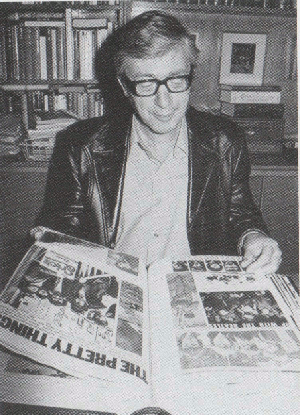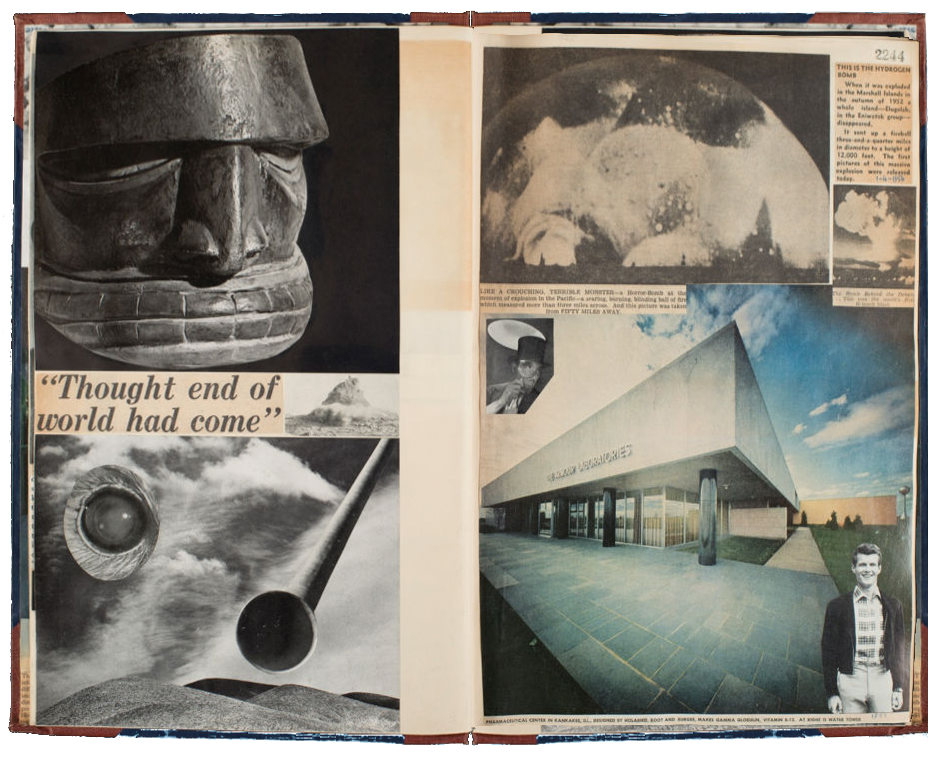View the Scrapbooks
You can browse a sample of pages from Edwin Morgan’s Scrapbook 12 in the Annotator: http://copyrightcentral.arts.gla.ac.uk/ema/ (opens in new tab)
What is Scrapbook 12?
The Scrapbook was created between 1954 and 1960 and there are 18 pages available to view. Find out more about the series of 16 Scrapbooks here.
How to Use the Annotator
Choose a double page view by selecting from the dropdown menu at the top left. On each Scrapbook page, clicking on individual cuttings brings up more information, such as the creator and source (if known), the rights status and a risk level.
What is the Risk Filter?
You can select a tick box to view the scrapbook under the risk filter, or untick to view without the filter. Use the slider to show what is visible if you have a low, medium or high appetite for risk.
The risk level has been calculated by taking into account the copyright status of the item. For example, anything which is out of copyright, has been cleared for use or is too insubstantial to attract copyright protection is Low (or No) risk. Medium risk items are typically cuttings which are believed to be in copyright but no information can be found on the rightholder and high risk items are still in copyright, with an identifiable rightholder.
Using the filter shows how many of the items are visible when using a risk-based approach to rights clearance, underlining the benefits of taking a robust approach to risk so that more of a collection is available to view.
 |
|
© The Estate of Marshall Walker |
If you would like to see any of Edwin Morgan’s 16 Scrapbooks, or any other items from his personal archive, contact Archives & Special Collections in The University of Glasgow Library.
What is the Annotator?
The Annotator is an innovative, interactive tool developed by Jesus Rodriguez Perez at CREATe for this project. The Annotator allows the visualisation and the textual annotation of segments of any given image, in this case the Scrapbooks. The Annotator was developed as a web resource, utilising standard web technologies such as HTML; CSS; Javascript; etc.
The main challenge of the project was the image manipulation of the original Edwin Morgan pages, and to allow the annotation of the different works within a page, by means of an overlay layer with the annotations.
At the core of the solution sits the programming library “fabric.js” which allows for the manipulation of images. This is achieved by leveraging the power of HTML 5 technologies, but specifically by making use of the “Canvas” html component. Additionally, the annotated data itself is stored in a simple table within a relational database (Postgres) which is accessed through PHP scripts in the back-end. The data contains not only the textual information associated to an annotation, but also the coordinates of the segment within an image that the annotation relates to. Thus, thanks to the on-the-fly image manipulation capabilities of fabric.js and HTML 5, a graphical preview of the segments can be generated on the front-end out of the coordinates any time the site is accessed.
Can I use the Annotator tool for my own projects?
Yes, it is available for free: https://github.com/rpsoft/EMA/
Copyright Statement Credits Contact
Please cite this resource as: R. Deazley, K. Patterson and V. Stobo, Digitising the Edwin Morgan Scrapbooks (2017), www.digitisingmorgan.org








